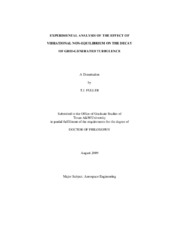| dc.description.abstract | The technical feasibility of hypersonic flight (i.e., re-entry, hypersonic flight vehicles, cruise missiles, etc.) hinges on our ability to understand, predict, and control the transport of turbulence in the presence of non-equilibrium effects. A theoretical analysis of the governing equations suggests a mechanism by which fluctuations in internal energy are coupled to the transport of turbulence. Numerical studies of these flows have been conducted, but limited computational power results in reduced fidelity. Experimental studies are exceedingly rare and, consequently, experimental data available to build and evaluate turbulence models is nearly non-existent.
The Decaying Mesh Turbulence (DMT) facility was designed and constructed to generate a fundamental decaying mesh turbulent flow field with passive grids. Vibrational non-equilibrium was achieved via a capacitively-coupled radio-frequency (RF) plasma discharge which required an operating pressure of 30 Torr. The flow velocity was 30 m/s. Data was recorded with each grid at multiple plasma powers (Off, 150 W, and 300 W). Over two terabytes of highly resolved (3,450 image pairs) two-dimensional particle image velocimetry (PIV) was acquired and archived. Temperature measurements were carried out using coherent anti-Stokes Raman spectroscopy (CARS).
The primary objective of this study was to answer the fundamental scientific question: "Does thermal non-equilibrium alter the decay rate of turbulence?" The results of this study show that the answer is "Yes." The results demonstrate a clear coupling between thermal non-equilibrium and turbulence transport. The trends observed agree with those expected based on an analysis of the Reynolds stress transport equations, which provides confidence in transport equation-based modeling. A non-trivial reduction (~30%) in the decay rate downstream of the 300 W plasma discharge was observed. The data also show that the decay of TKE downstream of the plasma discharge was delayed (~20% downstream shift). In addition, the thermal non-equilbrium was observed to have no effect on the transverse stress. This suggests that, for this flow, the energy dilatation terms are small and unaffected by the plasma discharge, which simplifies modeling. | en |


